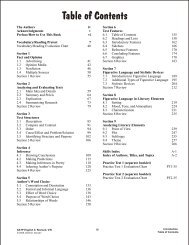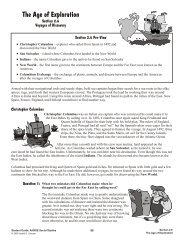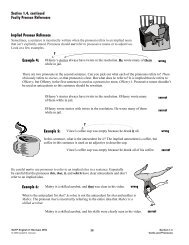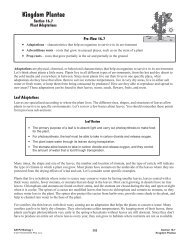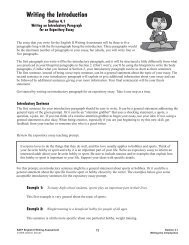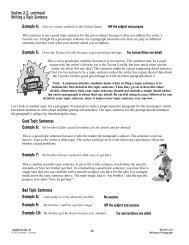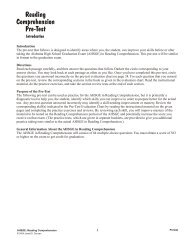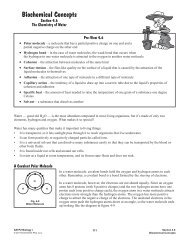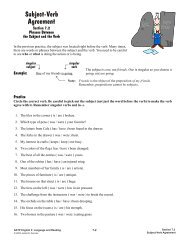Mississippi SATP2 Algebra I Student Review Guide - Enrichment Plus
Mississippi SATP2 Algebra I Student Review Guide - Enrichment Plus
Mississippi SATP2 Algebra I Student Review Guide - Enrichment Plus
Create successful ePaper yourself
Turn your PDF publications into a flip-book with our unique Google optimized e-Paper software.
Rational Expressions<br />
Section 11.2<br />
Negative Exponents<br />
So far all the division of monomials you have seen has been with positive exponents.<br />
What happens when the rational expression has negative exponents? You pray. Just<br />
kidding. Negative exponents aren’t really that bad. You just have to pay attention —<br />
very careful attention. Let’s start with a short review of what you already know about<br />
negative exponents.<br />
Rules for Negative Exponents<br />
–7<br />
y<br />
–3 2<br />
x y<br />
2<br />
y<br />
2<br />
x<br />
3 –2<br />
x y<br />
–2 –2<br />
2x y<br />
–3 –4<br />
3x y<br />
1<br />
7<br />
y<br />
2<br />
y<br />
3 2<br />
x y<br />
2 2<br />
x y<br />
3<br />
x<br />
3 4<br />
2x y<br />
2 2<br />
3x y<br />
You’ve already seen that you can make a negative exponent positive by making it the<br />
denominator of a fraction. But what if you already have a rational expression and the<br />
negative exponents are in the numerator or denominator? You move them. Here’s how.<br />
If the negative exponent is in the numerator, you move it to the denominator. If the<br />
negative exponent is in the denominator, move it to the numerator. It’s just that simple.<br />
When you move negative exponents, they become positive.<br />
If you have all negative exponents in the numerator and the denominator, the variables<br />
swap places. Make sure you don’t swap the coefficients; they already have a positive<br />
exponent. They’re raised to the power of +1.<br />
Negative Exponents in Rational Expressions<br />
If a rational expression has negative exponents, use the rules above to make them positive. Once you make the<br />
exponents positive, you can simplify the rational expression by canceling common factors. Take a look at these<br />
examples.<br />
Example 1: Simplify the expression 2 2 3 .<br />
–3<br />
4 –2<br />
16x y z<br />
12x y z<br />
Since there are negative exponents in the numerator, you move them to the<br />
denominator. Once all the exponents are positive, you can add the exponents<br />
that have the same base.<br />
–3 4 –2<br />
16x y z<br />
2 2 3<br />
12x y z<br />
Step 1: Move the negative exponents to the denominator and<br />
make them positive. Remember to move both the base<br />
and the exponent. Don’t move just the exponent.<br />
Step 2: Add the exponents with the same bases.<br />
Step 3: Factor the coefficients if you can.<br />
Step 4: Cancel the common factors in the coefficients and use<br />
the shortcut to cancel exponents.<br />
Step 5: After cancelling, regroup what’s left.<br />
4<br />
16y<br />
2+3 2 3+2<br />
12x y z<br />
4<br />
16y<br />
2 3 2 3 2<br />
12x x y z z<br />
2<br />
y<br />
4<br />
4 • 4y<br />
5 2 5<br />
4 • 3x y z<br />
2<br />
4y<br />
5 5<br />
3x z<br />
4<br />
16y<br />
5 2 5<br />
12x y z<br />
<strong>SATP2</strong> <strong>Algebra</strong> 187<br />
© 2010 <strong>Enrichment</strong> <strong>Plus</strong>, LLC<br />
Section 11.2<br />
Rational Expressions



